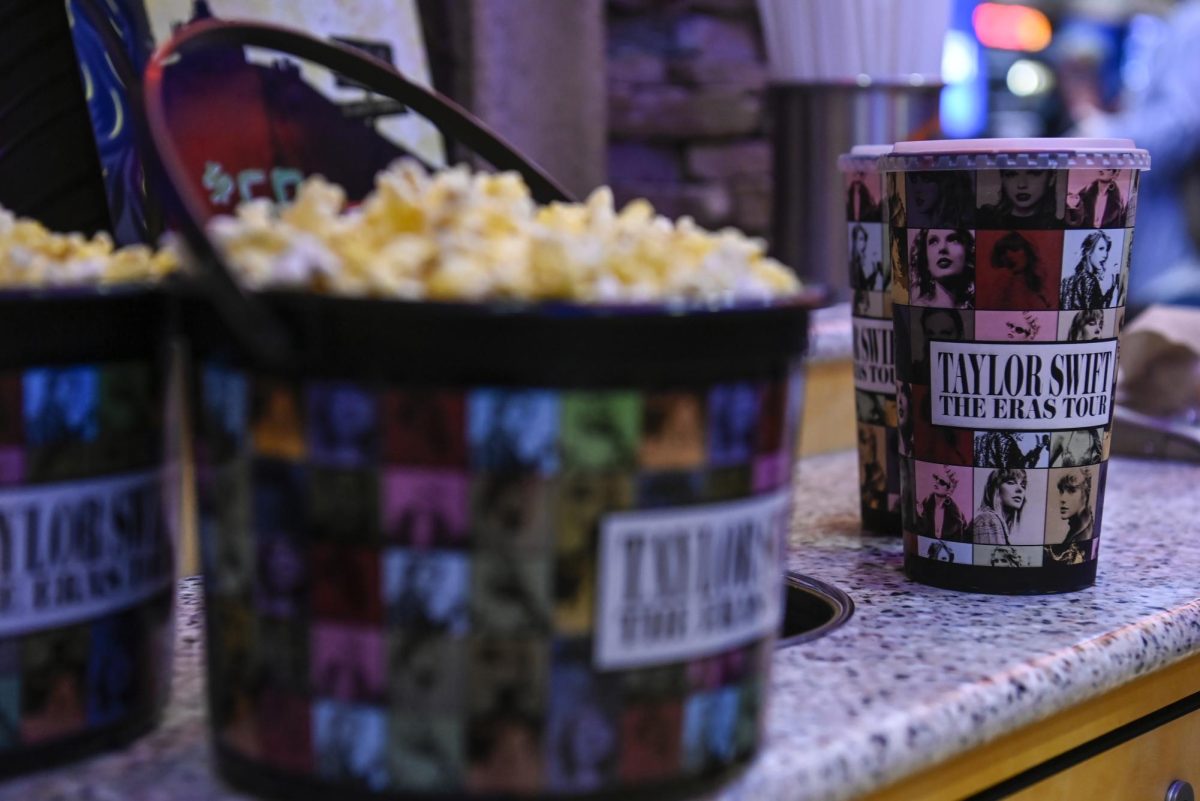“You know the greatest films of all time were never made,” sings Taylor Swift in “the 1” from her 2020 album “folklore.” But this prolific songwriter may have some rewriting to do, because “Taylor Swift: The Eras Tour” may just be one of the greatest concert films of all time.
“Taylor Swift: The Eras Tour” is the highly anticipated concert film based on Swift’s globally sensational Eras Tour. Swift and director Sam Wrench journey through 17 years of music, one album at a time.
When Swift announced the tour last November, unprecedented demand for tickets left many fans empty handed or with empty bank accounts. The popularity of the tour had fans left watching grainy live streams from their beds, crossing their fingers for the day it would be released as a film. Luckily for Swifties, Swift didn’t even wait for the tour to conclude before announcing the film and releasing it in theaters Oct. 13. The film debuted with $39 million on opening day –– the biggest opening day in history for a concert film –– with 100% on Rotten Tomatoes and the rare A+ rating by CinemaScore.
Ticket prices for adults and children are $19.89 and $13.13, respectively, which may seem overpriced, but they’re affordable compared to $1,607, which was the average resale price of “Eras” tickets. Even though IMAX and Dolby tickets cost more, varying depending on theater and format, moviegoers can skip shelling out a chunk of their life savings.
Unsurprisingly, Taylor Swift is the heart of the film, lighting up the big screen with her dazzling dance moves and genuine gratitude for the people around her. Whether it’s by blowing kisses to the crowd or mouthing short quips like “I love you” to her dancers, Swift’s performance goes beyond the setlist and choreography. When the camera is behind her and captures her view of a sold out stadium, the viewer can almost taste mega-stardom as she experiences it. For a brief moment, we are Taylor Swift. But that feeling is short-lived, as the camera quickly disrupts that fantasy by changing shots, reminding us that there is only one Taylor Swift.
The editors match shots with the lyrics and rhythm. Only once does this technique fall short of exemplary. The “reputation” era, defined by its vengeful graphics and a black unitard complete with a blood-red snake that shares the hue of Swift’s signature lipstick, is the most chaotic of the eras in terms of editing. “…Ready For It?” opens with frequent cuts in tandem with the fast-paced beat, which turns disorienting after a few seconds. Just when it starts to feel dizzying, Swift reaches the chorus and we are relieved of the rapid editing. With this moment as the only exception, the decision to synchronize the shots and rhythm is effective because the viewer is placed inside the music, not just the theater.
Wrench also handles the movement of the stage itself with impressive ingenuity. At various times throughout the show, isolated sections of the stage rise to form platforms for Swift and her dancers. The videography effectively captures the changing configurations, but in a way that suits the specific song. During “Don’t Blame Me” from “Reputation,” a low-angle shot establishes Swift’s dominance and power as she dances over the snake-lined stage. Comparatively, close-ups create familiarity between Swift and the audience in the heartfelt ballad “All Too Well.” Though she stands on a platform for this song, too, she seems to rise with the audience instead of rise above them. Despite “All Too Well” being a 10 minute song, the way Wrench balances shots and duration leaves you asking why 10 minutes never feel that short in lectures.
When the close-ups linger long enough to feel like Swift exists alone in the world, Wrench cuts back to a long shot, revealing her place at the center of 70,000 people’s devotion. Just when you think she is alone in her heartbreak, her grief, her ebullience or her love, the camera proves isolation to be a trick of the eye and argues that no one in the room — stadium or theater — is alone in that moment. In this regard, the videography is an extension of her personal dedication to inclusivity.
Whether smiling her way through “Love Story” or belting out “You’re On Your Own, Kid” at the piano, Swift never fails to address the camera as if it was an old friend. Sly winks, heated glares, and gesticulations are occasionally addressed to the lens and the movie audience by extension.
Nothing can compare to the atmosphere of a stadium of Swifties, but the “Eras” film does its best to live up to the live concert. By capturing what could not be seen from most concert seats — the beads of sweat on her face, scuff marks on the stage, marking tape, sequin patterns on her costumes — moviegoers can revel in the illusion of being closer to Swift than ever. Sound mixer Jacob Farron Smith and sound editor Phil DeTolve make sure Swift’s vocal ability shines above the undercurrent of crinkling candy wrappers and the rattle of friendship bracelet-clad wrists reaching for popcorn. The film excels by placing well-deserved emphasis on each dancer, vocalist and band member, most of whom are inevitably overlooked at the live shows as fans are laser focused on Swift herself. Holistically, the film sticks to the concert experience by not including special features such as behind-the-scenes footage or interviews, other than performance “bloopers” and pictures of fans in the credits.
Under Wrench’s directorial guidance, the film effortlessly translates Swift’s performance from stage to screen for two hours and 48 minutes. When the last song of the set fades into a blur of confetti and heartfelt “I love you’s” to the crowd, Swift exits the stage and the big screen with one final bow. But even though the theater lights turn on and reality fades into view, her infectious enthusiasm lingers like a tattooed kiss.



